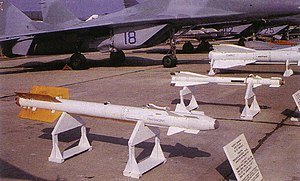Vympel R-73
| R-73 AA-11 Archer |
|
|---|---|

|
|
| Type | short-range air-to-air missile |
| Place of origin | Soviet Union |
| Service history | |
| In service | 1984-present |
| Production history | |
| Manufacturer | Vympel NPO (current),Tbilisi Aircraft Manufacturing (former) |
| Specifications | |
| Weight | 105 kilograms (231 lb) |
| Length | 2.93 metres (9 ft 7 in) |
| Diameter | 165 millimetres (6.5 in) |
| Warhead | 7.4 kilograms (16 lb) |
|
|
|
| Engine | solid-fuel rocket engine |
| Wingspan | 510 millimetres (20 in) |
|
Operational
range |
R-73E: 30 kilometres (19 mi) |
| Speed | Mach 2.5 |
|
Guidance
system |
All-aspect infrared homing |
|
Launch
platform |
|
R-73E: 30 kilometres (19 mi)
R-73M1: 30 kilometres (19 mi)
The Vympel R-73 (NATO reporting name AA-11 Archer) is a short-range air-to-air missile developed by Vympel NPO that entered service in 1984.
The R-73 was developed to replace the earlier R-60 (AA-8 'Aphid') weapon for short-range use by Soviet fighter aircraft. Work began in 1973, and the first missiles entered service in 1984.
The R-73 is an infrared homing (heat-seeking) missile with a sensitive, cryogenic cooled seeker with a substantial "off-boresight" capability: the seeker can "see" targets up to 40° off the missile's centerline. It can be targeted by a helmet-mounted sight (HMS) allowing pilots to designate targets by looking at them. Minimum engagement range is about 300 meters, with maximum aerodynamic range of nearly 30 km (19 mi) at altitude. The weapon is used by the MiG-29, MiG-31, Su-27, Su-34 and Su-35, and can be carried by newer versions of the MiG-21, MiG-23, Sukhoi Su-24, and Su-25 aircraft. India is looking to use the missile on their HAL Tejas. It can also be carried by Russian attack helicopters, including the Mil Mi-24, Mil Mi-28, and Kamov Ka-50/52.
The R-73 is a highly maneuverable missile and mock dogfights between USAF and German Air Force MiG-29s (inherited from the former Air Forces of the National People's Army) equipped with the R-73/helmet mounted cueing have indicated that the high degree of "off-boresight" capability of the R-73 would make a significant difference in combat. The missile also has a mechanically simple but effective system for thrust-vectoring. The R-73 prompted the development of a number of western air-to-air missiles including the IRIS-T, MICA IR, Python IV and the latest Sidewinder variant, the AIM-9X which entered squadron service in 2003.
...
Wikipedia
